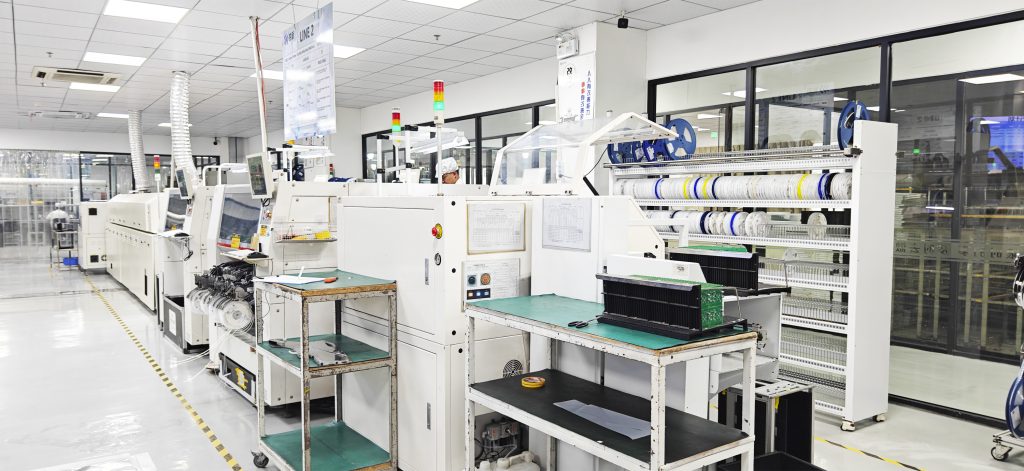Table of Contents
How to Choose the Right PCBA Service Provider?
PCBA stands for Printed Circuit Board Assembly, which refers to the entire process of assembling components onto a bare PCB through SMT (Surface Mount Technology) or DIP (Dual In-line Package) processes.
SMT vs. DIP
- SMT (Surface Mount Technology)
- Does not require drilling holes in the PCB.
- Uses pick-and-place machines to mount small components onto the PCB.
- Key process steps: PCB positioning, solder paste printing, component placement, reflow soldering, and inspection.
- Sensitive to component alignment, solder paste quality, and printing precision.
- Modern SMT can also handle larger components (e.g., mechanical parts on motherboards).
- DIP (Dual In-line Package / Through-Hole Technology)
- Requires inserting component leads into pre-drilled holes on the PCB.
- Used for larger components or when SMT is not feasible.
- Two methods: manual insertion and automated insertion.
- Key process steps: adhesive application (to prevent solder bridging), component insertion, inspection, wave soldering, cleaning, and final inspection.
Key Factors in Selecting a PCBA Service Provider
1. Define Your Requirements
- Product Complexity: Does it require HDI, multi-layer boards, or high-frequency materials?
- Order Volume: Prototype, mid-volume, or mass production?
- Certifications Needed: ISO 9001, IATF 16949 (automotive), IPC-A-610, ISO 13485 (medical).
- Additional Services: DFM analysis, functional testing (ICT/FCT), component sourcing, or full turnkey assembly?
2. Evaluate Technical Capabilities
- Equipment Level:
- SMT machine precision (e.g., 01005 component placement).
- AOI/SPI inspection, X-ray for BGA soldering.
- Support for flexible PCBs (FPC), rigid-flex, or mixed-technology assembly (e.g., through-hole reflow).
- Industry Experience: Case studies in automotive, medical, or consumer electronics?
- Design Support: Can they provide DFM feedback to optimize cost and manufacturability?
3. Supply Chain & Component Management
- Component Sourcing:
- Partnerships with authorized distributors (e.g., Arrow, Avnet) to avoid counterfeit parts.
- Support for customer-supplied parts (Consign) or full turnkey procurement.
- Inventory Management: Ability to handle long-lead components (MCUs, FPGAs).
- Cost Transparency: Detailed BOM breakdown to avoid hidden fees.
4. Quality Control System
- Testing Methods:
- Flying probe, functional testing (FCT), burn-in testing.
- Defect rate control (e.g., <0.1% for automotive).
- Compliance Standards: IPC Class 2 (commercial) or Class 3 (high-reliability)?
- Traceability: Batch numbers, soldering profiles, and full data logging.
5. Delivery Capability & Flexibility
- Production Capacity: Can they handle peak demand without delays?
- Lead Time: Prototypes (3–5 days), mass production (2–4 weeks).
- Emergency Response: Support for rush orders or design changes?
6. Cost & Value for Money
- Quotation Comparison: Unit price, NRE (non-recurring engineering) fees, and testing costs.
- Hidden Costs: Rework charges, MOQ (minimum order quantity) constraints.
- Long-Term Benefits: Volume discounts or strategic partnerships.
7. Location & Communication
- Local vs. Overseas: Time zone alignment, language barriers, logistics costs.
- Shipping & Tariffs: Impact on total cost and delivery time.
8. Reputation & References
- Customer Reviews: Industry forums, third-party ratings, or client referrals.
- Factory Audit: On-site visit to verify ESD controls and production management.
9. Contract & After-Sales Support
- Warranty Terms: Clarify rework/return policies.
- Technical Support: Post-production troubleshooting or design upgrades?
PCBA Assembly Services Selection Process

- Shortlist Candidates: Via trade shows (e.g., Expo Electronica), online platforms (Topfast, PCBway), or referrals.
- Request Quotes (RFQ): Submit Gerber files, BOM, and testing requirements.
- Prototype Testing: Small-batch trial to verify soldering quality and functionality.
- Final Evaluation: Balance technical capability, cost, and service quality.
Common Pitfalls to Avoid
- Don’t prioritize low cost over quality—poor soldering leads to higher failure rates.
- Verify component sources to prevent counterfeit parts.
- Ensure flexibility for design changes.
Additional Considerations
1. Environmental & Social Responsibility
- Compliance: RoHS, REACH, halogen-free requirements (critical for EU exports).
- Waste Handling: Proper disposal of solder waste and chemicals.
- ESG Standards: Labor rights and carbon footprint policies (e.g., Apple供应链要求).
2. Intellectual Property Protection
- NDA (Non-Disclosure Agreement): Mandatory for design files and BOM security.
- Data Security: Encrypted file transfers, and restricted access to confidential production lines.
3. Long-Term Partnership Potential
- Technology Roadmap: Can they adapt to new tech (SiC, 5G modules, chipset packaging)?
- Scalability: Will they grow with your needs? (Assess financial stability for small suppliers.)
4. Risk Mitigation Strategies
- Dual Sourcing: Avoid single-point dependency (critical in geopolitical tensions).
- Disaster Recovery Plan: Fire/power outage contingencies.
5. Hidden Service Details
- Packaging & Logistics: Moisture-proofing, anti-static measures, JIT/VMI support.
- Traceability Labels: QR codes/UUID for MES/ERP integration.
6. Cultural & Communication Fit
- Dedicated PM: 24-hour response time for technical queries.
- Problem-Solving Attitude: Proactive resolution (e.g., free rework for defects).
7. Industry-Specific Needs
- High-Reliability (Automotive/Medical):
- AEC-Q100 certified components.
- Cleanroom standards (ISO 14644-1 Class 8 for medical).
- Military/Aerospace:
- ITAR compliance, gold finger plating (≥0.1μm).
8. Exit Strategy
- Contract Termination: Unfinished order handling, tooling ownership transfer.
- Data Handover: Production parameters and test protocols for new vendors.
9. Legal & Compliance Risks
- Sanctions Check: Avoid suppliers on restricted entity lists (e.g., Huawei sanctions).
- Contract Clauses: Penalties for delays (e.g., 0.1% daily), force majeure terms.
Key Questions to Ask Suppliers
- “What was your longest order delay in the past 12 months, and why?”
- “Can you share a recent IPC-A-610 third-party audit report?”
- “How do you handle component obsolescence in our BOM?”
- “Do you allow on-site quality inspections by our team?”
These details minimize risks, especially for high-value or long-lifecycle products (industrial/medical devices). Always validate with a pilot order before full commitment.
